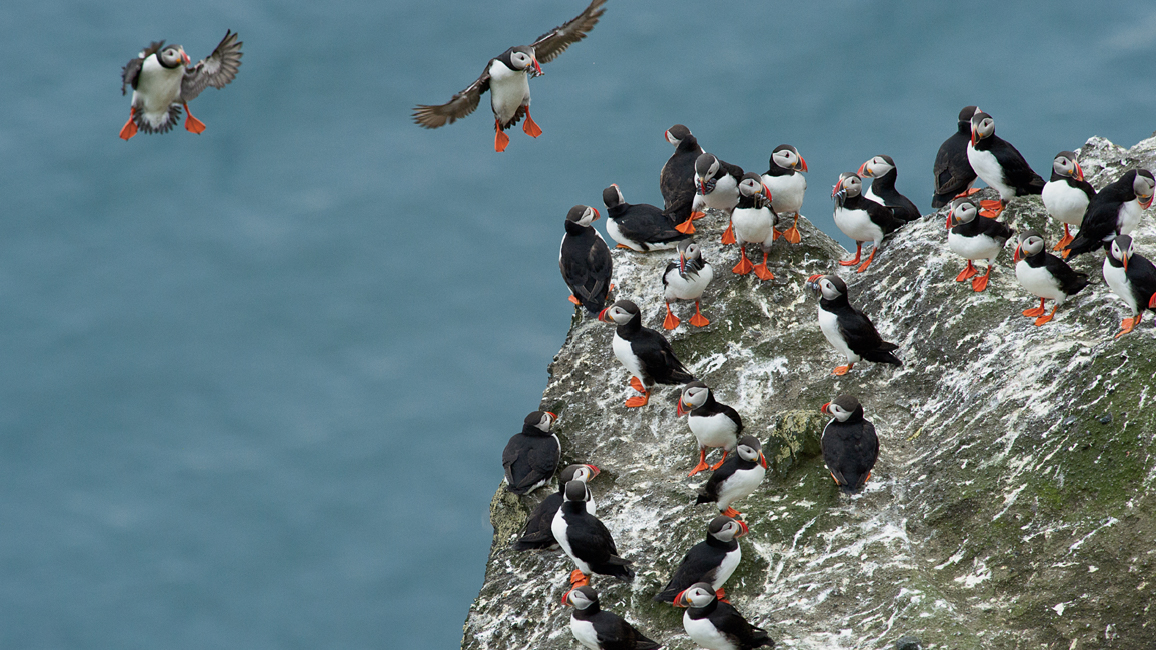
There’s Nothin’ Like a Puffin
By Kathy KrankingPuffins are right at home on steep, rocky cliffs. If you don’t mind the height, fly on over and meet these amazing birds!
There’s a lot to love about Atlantic puffins. Check out those colorful bills and flashy orange feet!
But puffins don’t just have cool looks. They do cool things. While most birds just fly through the air, puffins can fly through the air and the water. And puffins spend most of their lives living way out at sea. They return to land only when it’s time to raise their chicks. Want to see how they do it? Just turn the page.
Land Ho!
At nesting time, puffins come in for a landing after months at sea. They nest on islands or rocky cliffs along coasts of the northern Atlantic Ocean (see map on page 7).
In the spring, puffins get a “makeover.” Their bills and feet, which are drab in winter, turn brightly colored. This makes them more attractive to their mates.
Puffins usually mate for life, and, shortly after coming ashore, a pair begins looking for a place to make a nest. But the birds don’t look up, into the trees—there usually aren’t trees where puffins nest. Instead, they look down, because puffins nest in burrows—another special thing about these birds.
A puffin pair normally uses the same nest they have used other years. Or they may dig a new one. The two use their bills to dig, carving away at the soil. As they dig, they shovel the dirt out behind them with their clawed, webbed feet. The finished burrow can be longer than you are tall!
Next, the pair spends a lot of time gathering materials—such as grass or even feathers—to make a soft nest at the end of the burrow. While working on the nest, the puffins often stop to tap their bills together. This is called billing, and it’s the birds’ way of saying, “We’re mates, and we belong together.”
When the nest is finished, the female lays just one egg in it. Both parents take turns sitting on the egg to keep it warm. But they also take turns guarding the burrow entrance against other puffins that may try to take over the burrow.
Fishing for Baby
The parents take good care of their egg for about six weeks. Finally, a fluffy gray-and-white baby, called a puffling, hatches!
Now life gets really busy. The hungry chick needs to be fed several times a day. So it’s time for the parents to get fishing!
A puffin may fly as far as 30 miles out to sea to hunt fish for its chick. To catch the fish, the puffin uses its wings to “fly” underwater, steering with its feet. A puffin can carry lots of fish in its bill at a time—usually around 10 or so, but the record is more than 60! As it catches fish, the bird uses its rough tongue to hold them against spines on the roof of its mouth.
For the first few days after a puffling hatches, the parents take turns hunting for fish and feeding the chick. But soon both parents leave the chick to hunt.
Some years, puffin parents face problems finding food for their chicks. Possibly because of climate change, the waters can be too warm at nesting time. That means the parents can’t find the cold-water fish they need to feed their babies. Also, people have been catching too many fish for themselves. This has made it hard for puffins to find fish in some areas.
Geronimo!
When a puffling is about five to seven weeks old, it’s time for it to do an amazing thing. Under cover of darkness one night, it leaves the burrow. All by itself, it finds its way to the cliff’s edge. And then it jumps off! It may bounce along the cliff side until it finally lands in the water. Then it paddles away.
The young puffin is beginning its life at sea without any help from its parents. It won’t return to land for another two years. And it will be another three or four years before it’s ready to mate. By then it will be sporting its colorful bill and feet—ready to dig a burrow and have a puffling of its own.
“There’s Nothin’ Like a Puffin” originally appeared in the April 2016 issue of Ranger Rick magazine.
(Click on each image above for a closer view of the story.)



















